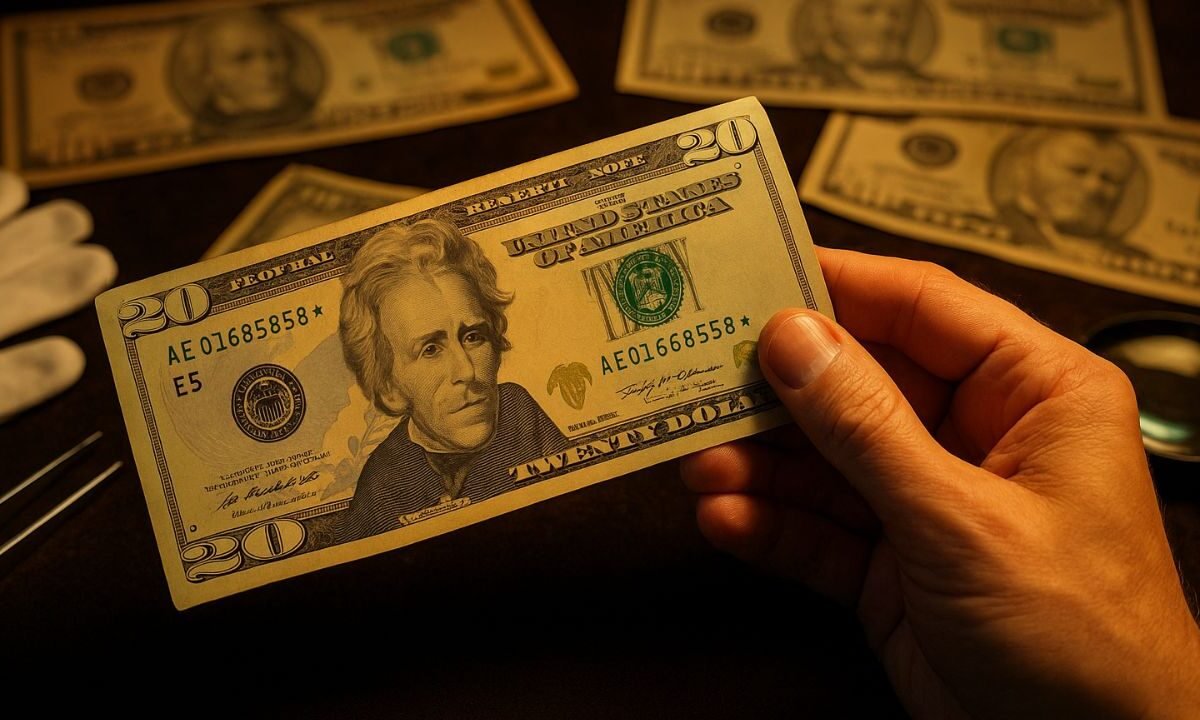Think a $20 bill can only buy lunch? Think again. Certain rare $20 notes—from historic large-size issues to eye-popping printing errors—have sold for five and even six figures at auction.
This guide highlights the key $20 bills, how to identify them, and what makes them worth over $10,000 right now.
Why Some $20 Bills Are Worth a Fortune
Collectors pay big money when a note is exceptionally scarce, historically important, in high grade, or shows a dramatic error.
Standout examples include the famous “Del Monte” banana-sticker error (a modern $20 that brought nearly $400,000), the vivid 1905 “Technicolor” $20 Gold Certificate, and Civil-War-era 1861 $20 Demand Notes—all known for record prices.
The Most Valuable $20 Bills to Watch For
| Type / Series | What to Look For | Why It’s Valuable | Typical High-End Results* |
|---|---|---|---|
| 1996 $20 “Del Monte” Error | Banana sticker printed over the Treasury seal (“retained obstruction”) | Most famous U.S. error note; huge publicity; unique visual | Sold for about $396,000 (2021) |
| 1905 $20 “Technicolor” Gold Certificate | Large-size note with multicolor face; high grades | Iconic design, fierce demand, low surviving population in Gem | Frequently estimates/realizations in the six-figure range in top grade |
| 1869 $20 “Rainbow” Legal Tender (Fr. 127) | Bold multicolor inks; Gem Uncirculated examples | Trophy-grade large-size type; rarely seen in Gem | Offered as auction highlights; five-figure to six-figure potential in Gem |
| 1861 $20 Demand Note | Early Civil War issue; district varieties (e.g., New York) | Extremely scarce; foundational federal paper money | Price guides show high five-figure levels; rarities can exceed $100,000 |
| 1929 $20 National Bank Notes (scarce charters) | Small-size National notes from rare banks/towns | Local scarcity; some charters extremely limited | Choice examples from tough banks can reach $10,000+ |
*Results depend on grade, rarity, demand, and eye appeal; auction hammer prices fluctuate.
How to Check Your $20 Bill in 5 Steps
- Identify the series and type. Look at the series year, size (large-size pre-1929 vs small-size 1928+), and whether the note is a Gold Certificate, Legal Tender, Demand Note, Federal Reserve Note, or National Bank Note.
- Search for dramatic errors. Obvious retained obstructions, mismatched serials, misalignments, or wrong back/face pairings can be worth many multiples of face. The headline example is the Del Monte note.
- Check bank/title for Nationals. On 1929 National Bank Notes, the charter name/town can make all the difference—some small towns or short-lived banks are rare.
- Assess condition. Uncirculated (UNC) and Gem graded notes command top dollars; folds, stains, or pinholes reduce value sharply.
- Verify and grade. For high-value candidates, certification by a major grading service builds buyer confidence and helps unlock top prices, especially on six‐figure material like Technicolor and Rainbow notes.
The Del Monte $20—From ATM Find to Record Price
A college student once found a $20 with a Del Monte banana sticker that went through the presses—so the Treasury seal printed on top of the sticker.
That quirky error sold for about $10,000 on eBay, then about $25,300 at auction, and ultimately about $396,000 in 2021—becoming the most expensive error banknote on record.
Pro Tips to Maximize Value
- Don’t clean or press the note—this can be detected and will lower the grade.
- Use gloves or handle by edges; store in mylar currency sleeves.
- Document provenance (old collections, estate finds, bank straps).
- Sell at the right venue. Major currency auction houses attract global bidders for six-figure material like 1905 $20 Gold Certificates or 1869 Rainbow notes.
Common $20 Features That May Add Value
- Star notes (★) from tiny print runs and certain districts/series can be desirable.
- Fancy serial numbers (00000001, ladders 12345678, repeaters, radars) bring premiums—especially on crisply uncirculated notes.
- High-grade modern notes with dramatic ink shifts, overprints, or fold-over errors can leap from face value into the thousands.
While most $20 bills are worth exactly $20, a small group can fetch $10,000–$100,000+ thanks to rarity, condition, historical importance, or spectacular errors.
Keep an eye out for the 1905 Technicolor $20, 1869 Rainbow $20, 1861 Demand Notes, scarce-charter 1929 Nationals, and once-in-a-lifetime errors like the Del Monte—all proven heavy hitters with serious collector demand.
If your note checks any of these boxes, consider professional grading and selling through a top-currency auction to realize its full potential.
FAQs
I found a $20 with a weird stamp or sticker—could it be valuable?
If the object was on the note during printing (a retained obstruction) and design elements are printed over it, it could be extremely valuable—like the Del Monte note.
Which older $20 bills most often break $10,000?
Large-size trophies such as the 1905 Technicolor Gold Certificate, 1869 Rainbow Legal Tender, and 1861 Demand Notes, plus rare 1929 National issues from tough banks, commonly achieve five figures and up in strong grades.
Do small-size modern $20s have value beyond face?
Yes—especially major error notes, low-print-run star notes, and fancy serials in uncirculated condition. Exceptional errors can hit five or six figures, as history shows.

